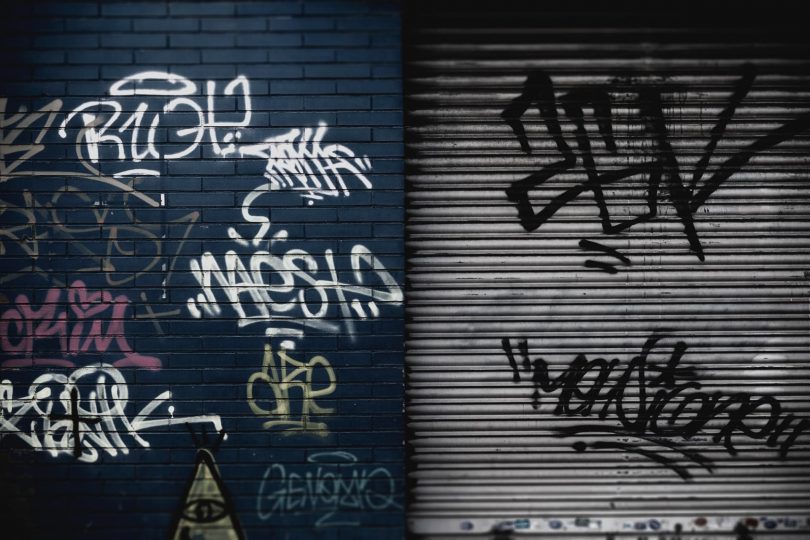There’s a lot of learning involved if you’re starting out with graffiti. So it’s nearly impossible to avoid mistakes early in your graff career.
But what if you knew the inside rules before you’re fully immersed in graffiti culture? There’s no doubt you’ll have the upper hand.
Well, you’re in luck. Here are the top 12 unwritten rules of graffiti that new writers need to know.
1. Don’t snitch
This rule is pretty simple. Never talk to the police or snitch on other graffiti writers to someone.
It doesn’t matter how much you don’t like the other writer or how much trouble snitching will get you out of. Never get another graffiti writer in shit.
You’re all in the graff game together, so never snitch on anyone who’s on the same team as you. Plus, being a snitch isn’t a good thing to be known for.
2. Don’t write on religious buildings or war memorials
Writing on a religious building or war memorial won’t get you any respect from other writers. And if it does, it’s not the crowd you want to attract.
Graffiti on these kinds of places is disrespectful and will most likely be taken the wrong way by the public and other graffiti writers.
Plus, you’re likely to get in way more trouble if you’re caught compared to a normal wall.
Unless you’re politically motivated (which is beyond graffiti culture), then don’t write on places of worship or war memorials.
3. Don’t write on houses
Another pretty simple rule. Never paint on people’s houses.
There might be exceptions to this in places where graffiti is tolerated. But generally speaking, it’s never a good look to write on someone’s house.
It’ll probably be buffed quickly and you’ll look like an asshole. Avoid it.
4. Don’t write on cars
Similar to houses, don’t write on other people’s cars.
There are exceptions to this, like if a car is abandoned. But painting on the average Joe’s car isn’t a good way to get up.
Again, you’ll just look like an asshole who’s costing a regular person money and grief.
This doesn’t include commercial vehicles like box trucks by the way, which can be fair game to paint depending on the situation.
5. Don’t go over someone who’s been in the game longer than you
Unless you wanna get in beef from day 1, avoid going over anyone who’s more experienced than you or has a better graffiti style than you.
Taking someone out who’s been in the game longer isn’t a good look. Other writers will see that you’re new to the game and haven’t learnt your local history.
If you’re starting out, practice on chill walls or simply find spots where you don’t need to go over anyone.
6. Throw-ups over tags, pieces over throw-ups, burners over pieces
If you are gonna go over someone, you need to do something better than they did. Otherwise, it’s going to look like a diss.
The unwritten rule is that throw-ups go over tags, pieces go over throw-ups and burners go over pieces.
If you can’t do something better than the last person, leave it alone.
It’s also good etiquette to bury the piece if you’re going over it. That means leaving no sign that there was a piece under yours.
7. Never paint over a dead writer’s work
This is probably one of the biggest mistakes any graffiti writer can make.
Never ever paint over a dead graffiti writer’s work. It’s a massive sign of disrespect and you’ll likely have all your stuff taken out for the foreseeable future.
It can be hard to tell sometimes. But generally speaking, if a very old piece hasn’t been touched, especially in a busy area where new pieces are going up, it’s best to leave it alone to be safe.
If you’re painting over something, make sure you know for sure that person is still around.
8. Never paint over a tribute piece
Tribute pieces are pieces dedicated to dead graffiti writers.
They’re usually painted by the friends of the dead writer, so it’s a massive sign of disrespect to go over one.
If you see the letters R.I.P in a piece, it’s probably best to avoid it if you want to preserve your reputation.
9. Don’t ask to be put in crews
Graffiti crews are informal networks of graffiti writers who paint together.
They commonly have 2-4 letter acronyms for their crew’s name. Members of the crew put these letters up to put their crew’s names on the map.
Crews are often tight-knit groups, so asking to be put in one isn’t a good look.
Getting into a crew should be decided based on your style and how much you’re committed to getting up. So never ask to be put in one.
Put in the work until the crews come to you.
10. Learn your history
There’s nothing more toy than someone who paints but knows nothing about the history of graffiti.
At the very least, Subway Art is a graffiti book that you need to read before you start writing. It’s known widely as the graffiti bible, and documents graffiti during its founding years in 1970s NYC.
Learn the lingo, read books and watch graffiti documentaries to avoid embarrassment. Learn as much as you can and don’t stop.
You might like: How to Choose Your Graffiti Name (8 Pro Tips & Tricks)
11. Leave no trace
If you’ve just painted a spot, never leave spray paint, spray caps or any other evidence apart from your tag.
Leaving half-empty cans and used caps means people will probably pick them up and write over your work or other writers’ work.
Plus, littering isn’t cool. So take everything with you, and only leave your tag.
12. Don’t act tough
Graffiti is full of inflated egos. Just because you write doesn’t make you tough.
At the core of it, graffiti is writing your name on something. That’s it.
Graffiti culture has evolved around this act, which has created an incredible movement. But it’s important to zoom out and remain humble.
Graffiti writers who have been in the game for longer than you will see straight through the tough-guy image.
Focus on getting up and improving your style. Don’t try to make up for it by acting tough.
Know an unspoken graffiti rule that I’ve missed? Drop a comment below and I might add it to this list.




